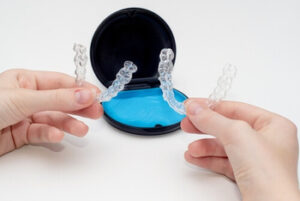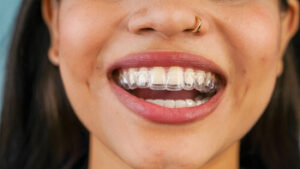If the idea of straightening your teeth sounds appealing, but the thought of wearing metal braces puts you off, you’re not alone. Many Australians now opt for more subtle ways to improve their smiles, and Invisalign is often at the top of the list.
But before you jump in, you might wonder: is Invisalign worth it?
This guide covers everything you need to know. From how Invisalign clear aligners compare to traditional braces to the factors that influence the cost of Invisalign, we’ll help you decide if this advanced dental treatment matches your personal dental needs.
What Is Invisalign and How Does It Work?

The process begins with a comprehensive consultation, during which your dentist assesses your teeth and designs a personalised treatment plan using advanced 3D digital imaging. This digital roadmap outlines the step-by-step transformation of your smile. Based on this, you’ll receive a sequence of aligners, with each set slightly adjusting your teeth’s position.
Typically, you’ll switch to a new set every one to two weeks until your teeth reach their final, aligned position.
Why Invisalign Continues to Be a Popular Choice
Let’s take a closer look at why so many Australians are choosing Invisalign for their orthodontic treatment.
1. Subtle and Discreet
The aligners are clear and crafted to match the natural appearance of your teeth, offering a great alternative for those who want to avoid the prominent look of metal braces.
2. Designed for Comfort
Since the aligners are made from smooth plastic and are individually tailored, they fit snugly and comfortably over your teeth. There are no brackets or wires that can irritate or cause discomfort.
3. Easy to Remove
You can remove your aligners before meals or while brushing, allowing you to enjoy all your favourite foods and maintain your usual dental hygiene routine without restrictions.
4. Supports Better Oral Hygiene
When you can remove your aligners, cleaning your teeth becomes much simpler. Unlike braces, which make brushing and flossing more difficult, Invisalign encourages good oral hygiene and helps prevent plaque and decay.
5. Clear Treatment Timeline
The use of 3D imaging technology gives you a visual representation of your entire treatment plan, showing how your smile will evolve over time.
Invisalign vs Traditional Braces: What Sets Them Apart?
When choosing between Invisalign and traditional braces, it is important to understand the key differences:
Appearance
Invisalign clear aligners are almost invisible, making them a discreet option for straightening teeth. Traditional metal braces, with visible brackets and wires, are far more noticeable.
Comfort
Made from smooth plastic, Invisalign trays are designed to provide comfort and minimise irritation. In contrast, metal braces can cause discomfort, especially after adjustments.
Removability
Invisalign aligners are simple to remove when you need to eat, drink, brush, or floss, whereas braces are permanently fixed and stay in place until the end of treatment.
Diet and Food Flexibility
With Invisalign, no food restrictions exist; you can eat whatever you like after removing your trays. In contrast, traditional braces require you to avoid hard, sticky, or chewy foods that often damage the brackets or wires.
Oral Hygiene
Cleaning your teeth is simpler with Invisalign, as you can brush and floss normally. Braces make daily oral care more difficult, increasing the risk of plaque and decay.
Appointments and Adjustments
Invisalign patients usually have fewer dental visits, with checkups every 6 to 8 weeks. Traditional braces often need more frequent appointments for tightening and adjustments.
Suitability for Dental Issues
Invisalign is ideal for mild to moderate orthodontic issues such as crooked teeth or minor bite problems. For complex dental issues, such as severe misalignment or significant jaw concerns, traditional braces may be more effective.
Choosing the right option depends on your dental needs, lifestyle, and commitment to following your treatment plan.
How Much Does Invisalign Cost in Australia?
Invisalign costs can differ, but generally, prices start at around $6,000. The exact amount will depend on several important factors:
- The severity of your misaligned teeth
- The length and complexity of your treatment plan
- If any extra dental treatment is needed (e.g. extractions)
- The rates set by your dental professional
- Your geographic location
- Your insurance coverage
Some dental insurance plans cover part of the cost, particularly if they include orthodontic benefits. Always check with your insurer to understand what’s included.
If you’re worried about the overall cost, ask your clinic about payment plans that allow for monthly instalments.
Who Is Invisalign Best Suited For?
Invisalign is an ideal choice for people with mild to moderate alignment concerns. It works particularly well if you have:
- Slightly crooked teeth
- Small gaps between your teeth
- Minor bite issues, such as a mild overbite or underbite
- Crowding or slight rotation of teeth
If your teeth need only minor corrections, Invisalign clear aligners can be a convenient and highly effective solution. They offer the flexibility to remove your aligners when needed, making them ideal for those who value both aesthetics and practicality during their orthodontic treatment.
However, traditional metal braces or a combination of other orthodontic appliances may be more suitable if you are dealing with more complex dental issues, such as significant jaw misalignment, severe crowding, or major bite problems.
Ultimately, the best way to know if Invisalign treatment is right for you is to book an initial consultation with your dentist. They will assess your smile, discuss your goals, and recommend a treatment option tailored to your needs.
Consistency Is Key: Wearing Aligners Regularly
The success of Invisalign treatment relies on how consistently you wear the aligners. They need to stay in for 20 to 22 hours a day. You should only remove them when eating, drinking (except water), brushing, or flossing.
Failing to follow the schedule may extend your treatment duration, impact your progress, and increase your overall cost. Braces may be a better fit if you’re worried about forgetting to wear your trays.
How Long Will My Invisalign Treatment Take?
The typical duration of Invisalign treatment falls between six and eighteen months, depending on your individual case.
Simple alignment issues may resolve quickly, while more involved treatments could take longer. For less complex corrections, Invisalign can be just as fast, or even faster, than traditional metal braces.
To keep your treatment on track, you will need to see your dentist every 6 to 8 weeks for a progress review and to receive your next set of removable aligners.
How to Keep Your Teeth and Trays Clean
Keeping up with good oral hygiene during Invisalign treatment is straightforward, particularly when compared to traditional braces.
Here’s what your daily routine might look like:
- Remove aligners before meals or drinks (except water)
- Rinse trays with lukewarm water throughout the day
- Brush your teeth after eating
- Clean your trays with a soft toothbrush
- Continue with regular dental checkups
Because you can remove the trays, keeping your teeth clean and healthy throughout treatment is much easier.
Is Invisalign Right for Everyone?
Invisalign is effective for many dental cases, but not all of them. Traditional metal braces may sometimes be the better option if you have severe bite misalignment, jaw complications, or rotated teeth that need significant repositioning. This is why having a thorough consultation is essential. Your dentist will assess your condition and suggest the most suitable treatment option for you.
Does Invisalign Fit Into Your Lifestyle?
If you’re someone who wants a flexible and subtle way to straighten teeth, Invisalign is a great choice. It works particularly well for:
- Busy professionals
- Teenagers and adults who are mindful of their appearance
- People returning to orthodontic treatment
- Anyone wanting a low-maintenance smile transformation
The ability to eat what you like and clean your teeth easily, unlike braces, makes Invisalign a strong option for many.
Frequently Asked Questions
How many hours a day should I wear my Invisalign trays?
You’ll need to wear them for 20 to 22 hours a day to keep your treatment on schedule.
Does Invisalign cause discomfort?
Some mild pressure is normal when switching trays, but it usually settles within a few days.
Can I eat anything with Invisalign?
Yes! You can remove the trays before meals, so there are no restrictions; just brush them before putting them back in.
Is Invisalign an option if I’ve had braces before?
Absolutely. Many people use Invisalign to correct shifting that happened after their braces were removed.
What should I do if I lose a tray?
Let your dentist know right away. They’ll advise you on whether to move to the next set or order a replacement.
Final Thoughts: Is Invisalign Really Worth It?
So, is Invisalign worth it?

Beyond aesthetics, Invisalign also promotes better oral health and long-term dental stability. Like any investment in your wellbeing, the decision comes down to your goals, lifestyle, and level of commitment.
If you are ready to start your smile transformation, do not hesitate to book an appointment with Dental 266 at 02 9051 0600. Our friendly team is here to guide you every step of the way.
References
- Aljawad, M. A., & Alqahtani, N. D. (n.d.). 3D Imaging Advancements and New Technologies in Clinical and Scientific Dental and Orthodontic Fields. Retrieved from https://pmc.ncbi.nlm.nih.gov/articles/PMC9031999/
- Colgate. (n.d.). What to know about metal braces. Colgate Oral Health. Retrieved from https://www.colgate.com/en-in/oral-health/adult-orthodontics/what-to-know-about-metal-braces
- Cleveland Clinic. (n.d.). Oral hygiene. Cleveland Clinic. Retrieved from https://my.clevelandclinic.org/health/treatments/16914-oral-hygiene
- Healthline. (n.d.). Does Invisalign work? Healthline. Retrieved from https://www.healthline.com/health/does-invisalign-work







